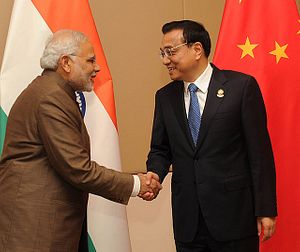The formation of the Asian Infrastructure Investment Bank is symbolic of Asia’s rising economic clout of Asia. About 75 percent of the bank’s initial $100 billion in capital will be drawn from the region, thus emphasizing its regional character. The AIIB is expected to be dominated by China. With 26 percent of the votes, China has the ability to veto resolutions requiring a three-quarters majority. At 7.5 percent, India has the second largest vote share in the Bank. Both China and India have initiated projects to improve connectivity that will ultimately enhance trade. The AIIB is well placed to become an instrument of the geo-economics of connectivity promoted by both these large Asian countries.
China’s Geo-Economics
One of the immediate targets of the AIIB financing is expected to be China’s “One Belt, One Road” (OBOR) project. This project aims to revive the old Silk Road as well as the old Maritime Silk Route; so as to connect the Pacific region with Europe on the land and with the Mediterranean by sea. China has already taken on board many countries in Central, South and Southeast Asia as partners in the project, by linking it to the development needs of these countries. It has successfully wooed even former rivals like Indonesia. China offers to construct roads, railways, and ports in these countries. A network covering Central, South, and Southeast Asian countries will provide land connectivity between these countries and China’s land-locked western and southern provinces. This will reduce its own dependence on the Indian Ocean sea lines of communication, thereby reducing the vulnerability of its trade. Thus, the AIIB could become an instrument of China’s emerging geo-economics.
However, given China’s increasing belligerence in the South China Sea and its growing interest in the Indian Ocean region, it is likely the OBOR project has more than economic implications. Countering U.S. and Japanese influence, and particularly the U.S. rebalance to the Asia-Pacific, is surely one of China’s strategic objectives in the region.
India’s Response
When it launched the OBOR project nearly two years ago, Beijing invited India to join. New Delhi had hesitation on two grounds: one, the strategic implications of this trade route, and two, the wisdom of connecting with areas that pose security concerns for India. In addition, there was apprehension about becoming strategically closer to China. In the broader Asia-Pacific context, New Delhi views Beijing was a rival, not a partner. In this regard, New Delhi’s interests converge with those of Washington (and Tokyo). Yet, in the global context, India is apprehensive about getting too close to the U.S. as well. It has thus been cautious both on China’s Silk Route project and the U.S. rebalance.
Early in the twenty-first century, New Delhi initiated at least two projects that sought better connectivity with its Asian neighbors. The first was the idea of an Iran-Pakistan-India (IPI) pipeline, while the second was the so-called “Look East” policy of improving relations with East and Southeast Asia. These projects subsequently stalled. But the Modi government has shown enthusiasm for reviving the concept of neighborhood connectivity. One of its own initiatives is the idea of “Project Mausam” – believed to be a counter to China’s Maritime Silk Route project. Another is the recently concluded Bangladesh-Bhutan-India-Nepal Motor Vehicle Agreement that confirms India’s commitment to provide access to the sea to the land-locked hinterland of the Indian Ocean (including its own Northeastern states). Another significant step was an unprecedented tour by Prime Minister Narendra Modi, covering Mauritius, Seychelles, and Sri Lanka in a single trip. (A visit to the troubled Maldives was cancelled.) On his recent trip to Central Asia and Russia, Modi revived the idea of the Turkmenistan-Afghanistan-Pakistan-India (TAPI) pipeline. In addition, the Indian government has mooted the idea of “Sagarmala,” or port-led development. Together, these initiatives underscore India’s emphasis on the Indian Ocean Region.
Connectivity is the crucial theme for growth and trade for China and India, as well as for the rest of Asia. Whether New Delhi joins Beijing’s OBOR project, or pursues connectivity independently, the two will essentially complement each other. The AIIB is set to be an important instrument in providing finance for these ambitious ideas. India should use its leverage in the AIIB to seek finance for its own connectivity projects. It has already been taking loans from the World Bank and the Asian Development Bank. AIIB funding will help India maintain its policy balance. And it will also help the country take proactive steps towards establishing its regional role.
Dr. Uttara Sahasrabuddhe is a Professor in the Department of Civics & Politics, University of Mumbai.

































